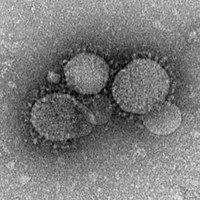
Photo from wikipedia
BackgroundPseudomonas aeruginosa (PA) is the most important opportunistic pathogen in causing nosocomial infections and, furthermore, poses a permanent threat for severe chronic infections in patients with cystic fibrosis or COPD.… Click to show full abstract
BackgroundPseudomonas aeruginosa (PA) is the most important opportunistic pathogen in causing nosocomial infections and, furthermore, poses a permanent threat for severe chronic infections in patients with cystic fibrosis or COPD. The transmembrane protein CD26 with dipeptidyl peptidase-4 (DPP4) activity shows an increased expression in inflamed tissue. We tested whether CD26/DPP4 deficiency leads to reduced inflammation and decreased structural damage when infected with PA.MethodsCD26/DPP4+ and CD26/DPP4− rats were instilled intratracheally with NaCl (controls) or with PA. Six hours later, bacterial distribution was detected with the in vivo imaging system 200 (IVIS). Lungs were then processed for molecular biology, light and electron microscopy and analyzed qualitatively, quantitatively and stereologically. Bacterial numbers were determined in homogenized lungs.ResultsCompared to saline treated controls, in both infected groups (1) the acinar airspace was significantly increased, (2) the volume density of the alveolar epithelium was significantly decreased, (3) the septal thickness was significantly reduced, (4) more than 40% of the alveolar epithelial surface was damaged, and up to 36% of the epithelial surface was covered with edema. In infected CD26− rats, the increase in lung weight was significantly less pronounced, the portion of edematous alveolar airspace was significantly lower and the part of edema interspersed with PA was decreased significantly.ConclusionsCD26/DPP4 deficiency resulted in reduced pulmonary edema under sublethal PA infection, implicating a role for CD26 in infection progression. The partly pronounced structural damage may mask further possible influences of CD26 on the inflammatory response.
Journal Title: Inflammation Research
Year Published: 2019
Link to full text (if available)
Share on Social Media: Sign Up to like & get
recommendations!